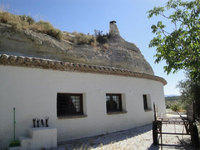Cave homes - The ultimate retreat from the pressures of modern life

Modern life can be stressful: political and financial worries, work-related stress and societal pressure to always be happy, healthy and at the top of your game all add up. According to the most recent Labour Force Survey, work related stress, depression and anxiety alone were responsible for 9.9 million lost working days in 2014/15. At times, the thought of ditching the strains of modern life and hiding out in a cave, hobbit-style, can be rather tempting. And with hundreds of cave houses available in the Spanish sunshine, many people are opting to do just that.
Martin Dell, Director of leading Spanish property portal Kyero.com, which lists more than 200,000 homes from 3,000 estate agents, comments, “Spain is home to some wonderfully unique and quirky properties and its cave houses are some of the most intriguing. Built into hillsides and mountainsides, often with the rock being painstakingly hollowed out by hand, these homes offer truly individual environments for people looking for a different lifestyle.”
Cave houses are particularly prevalent in Granada: Kyero.com has hundreds of Granada cave homes listed as available for sale. They range from ‘unreformed’ cave homes from as little as €9,000 (essentially a hole in the mountainside, with no utilities) to extensive properties designed for luxurious off-grid living. In Bacor, a split-level cave home of more than 1000 m2, flooded with natural light and complete with solar power and its own water supply is available for €475,000.
Sean Lummis of Spanish Inland Properties has been selling cave homes for more than a decade. According to Sean, not every mountain is suited to cave homes, meaning that they tend to crop up in pockets. He explains,
“Cave homes tend to be situated on the outskirts of certain dreamy whitewashed Spanish towns and villages because the rock formation. For instance, in Galera the rock type consists of a type of sedimentary sandstone with layers of hard, almost horizontal rock interspaced with much softer layers, which in prehistoric times were dug by hand. The harder rock formed a layer impervious to water and provided the strength needed for a safe, secure roof to the caves.”
Piet Quekel of Cuevas-Spain Inmobiliaria has also been specialising in selling cave homes since 2005, having lovingly restored his own cave home, purchased in 2002. He comments,
“Cave homes are plentiful in the Altiplano de Granada area. It’s a dramatically beautiful place, with big lakes, mountains, woodland and delightful little villages. Cave houses here come in many different shapes and sizes – their uniqueness is part of their charm. Generally a decent two bedroom cave house can be picked up for €40,000 to €60,000, while three bedroom ones range from €50,000 to €90,000.”
The delightful three bedroom cave home at Fuente Nueva is a great example. Available for €64,000, the traditional style home includes three bedrooms, an office, large family bathroom, living/party room complete with indoor barbecue and separate lounge with wood burning stove. There’s also a spacious courtyard style patio garden with further barbeque and ample room for parking.
Cave houses were popular homes for Spaniards in the 1950s and 1960s, but as the 1970s progressed and the Spanish economy improved many cave dwellers left their homes in favour of the attractions of local villages, which at that time included such technological advances as roads, electricity, running water and plumbing.
Many cave houses stood abandoned until the 1990s, when water and electricity began to be brought to cave areas, sparking a slow increase in interest. Once streets were made to access the caves, foreigners caught on to the vision of owning them as cost-effective holiday homes and the cave home boom began in earnest. British, Dutch, Belgian, French, American and German second home buyers all found their imaginations fired up by the simplicity and peace of the Spanish cave houses.
Today, cave homes remain popular with buyers from overseas, as Kyero.com’s Martin Dell explains, “The financial crash in the late 2000s had a marked impact on cave home prices, just as it did on other types of property in Spain. Cave prices are slowly picking up again, but remain fairly low for the moment, meaning that there are some impressive bargains to be had for those buyers looking for a sun-kissed holiday home that is affordable, close to nature and highly individual.”
Cave house running costs tend to be low. As part of the mountain, they remain at around 16°C and 18°C throughout the year. It means they don’t require air conditioning in the summer and only need a little heating in the winter. Annual taxes are generally in the region of €250 for the average cave home, according to Spanish Inland Property’s Sean Lummis. Electricity costs much the same as in the UK, while a gas bottle is just €13.
Most modern caves come complete with internet access, electricity or solar panels, drinking water and terraces. Some also have gardens and swimming pools. According to Cuevas-Spain Inmobiliaria’s Piet Quekel,
“There are cave hotels, cave restaurants and cave B&Bs. There are caves in villages and there are caves in the middle of nowhere. For every taste there is a cave!”
The soft lines and curves of cave homes are often found to be calming by their owners, as are the breath-taking views and rural peace that many provide. The perfect antidote to the stress of modern life!
For further details on cave homes to buy, visit kyero.com. For the latest data on the state of the Spanish property market, visit data.kyero.com.

